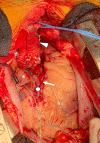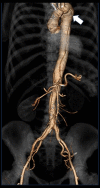Life-Threatening Aortic Dissection during Pregnancy: A Case Report of Undiagnosed FBN1-Related Marfan Syndrome at 39 Weeks Gestation
- PMID: 37743617
- PMCID: PMC10534165
- DOI: 10.12659/AJCR.940628
Life-Threatening Aortic Dissection during Pregnancy: A Case Report of Undiagnosed FBN1-Related Marfan Syndrome at 39 Weeks Gestation
Abstract
BACKGROUND Inherited deficiencies in the FBN1 gene, which encodes fibrillin-1, result in Marfan syndrome, an autosomal dominant connective tissue disorder that is associated with aortic root dilatation and predisposes to aortic dissection. This report is of a 37-year-old woman presenting at 39 weeks of pregnancy with acute thoracic aortic dissection due to previously undiagnosed FBN1-related Marfan syndrome. This case report aims to illustrate the challenges in the diagnosis and in the peri-operative management of acute aortic dissection during pregnancy. CASE REPORT A healthy 37-year-old woman at 39 weeks of gestation presented to our hospital with dyspnea and chest pain. Initial evaluation for pulmonary embolism with chest computed tomography was unrevealing. The patient was admitted to the intensive care unit for further management. Overnight, her clinical conditions deteriorated, and a transthoracic echocardiography was obtained, demonstrating an acute ascending aortic dissection. She emergently underwent a successful combined cesarean section and ascending aortic dissection repair, with no immediate complications. On postoperative day 4 she developed cardiac tamponade, for which she underwent emergent mediastinal exploration. She was discharged home on postoperative day 10. A month later she completed genetic testing, which revealed a pathogenic mutation in the FBN1 gene, consistent with a molecular diagnosis of Marfan syndrome. CONCLUSIONS This report has shown that FBN1-related Marfan's syndrome has a variable clinical presentation that can include life-threatening aortic dissection during pregnancy. Successful diagnosis and management of these patients is challenging and requires multidisciplinary expertise, including confirmation of the diagnosis by a clinical geneticist.
Conflict of interest statement
Figures





References
-
- Zhu JM, Ma WG, Peterss S, et al. Aortic dissection in pregnancy: Management strategy and outcomes. Ann Thorac Surg. 2017;103(4):1199–206. - PubMed
-
- Barison A, Nugara C, Barletta V, et al. Asymptomatic Takayasu aortitis complicated by type B dissection. Circulation. 2015;132(22):e254–55. - PubMed
-
- Carlson M, Airhart N, Lopez L, Silberbach M. Moderate aortic enlargement and bicuspid aortic valve are associated with aortic dissection in Turner syndrome: Report of the international turner syndrome aortic dissection registry. Circulation. 2012;126(18):2220–26. - PubMed
-
- Evangelista A, Isselbacher EM, Bossone E, et al. Insights from the international registry of acute aortic dissection: A 20-year experience of collaborative clinical research. Circulation. 2018;137(17):1846–60. - PubMed
Publication types
MeSH terms
Substances
LinkOut - more resources
Full Text Sources
Medical
Molecular Biology Databases

